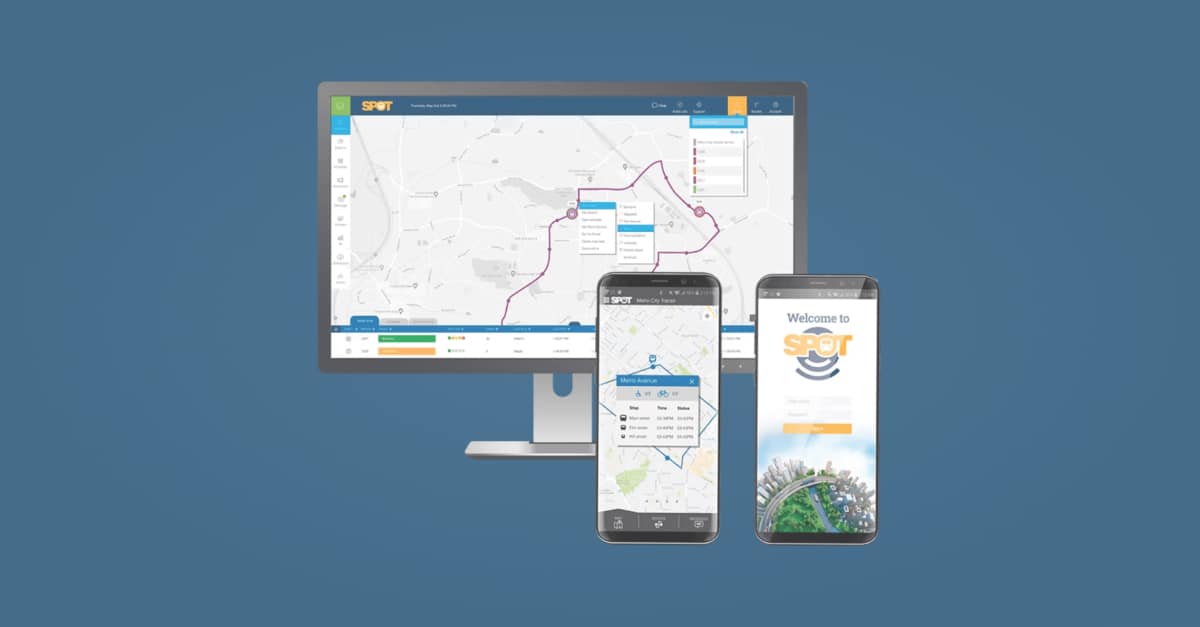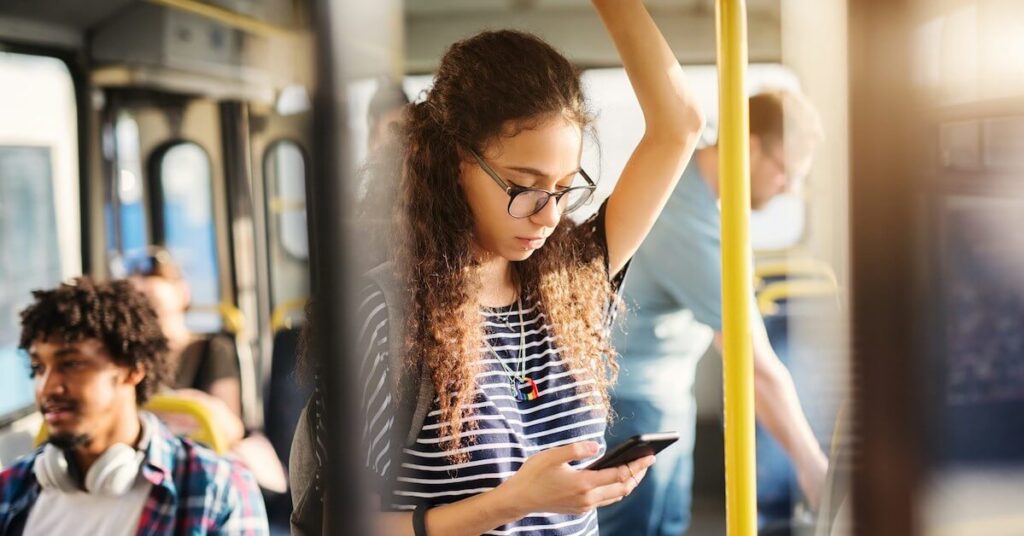00:00 Stop Requested.
00:02 Levi McCollum: Welcome to Stop Requested, the podcast where we discuss everything transit. I’m your co host, Levi McCollum, product manager at ETA Transit.
00:11 Christian Londono: And I’m your co host, Christian Londano, Senior customer Success Manager at ETA Transit. Hey, Levi.
00:21 Levi McCollum: Hey, Christian. How’s it going?
00:22 Christian Londono: It’s going good. It’s going good. Welcome back to the show.
00:26 Levi McCollum: Absolutely, man. What are we talking about?
00:30 Christian Londono: Well, it’s great to have you here today and I’m really excited about today’s episode because today we’re going to be talking about transit agency swag. To get started, I just wanted to get your definition of transit swag.
00:47 Levi McCollum: Yeah, well, swag stuff we all get. That’s an office reference for all the office listeners. So swag, in my mind as the branded merchandise from transit agencies, you know, it could be a beanie, it could be a squishy bus, it could be a hat. You know, you see it in all types of forms. I’ve gotten some pretty cool swag over the years and, you know, hopefully we get into that a little bit later because I’d like to share some of the things that I’ve received. But I think, in short, it’s just that branded apparel or merchandise that the agency gives out, you know, sometimes you have to pay for it, I guess, depending on the item, but most of the time I’ve seen it for free, give it out at trade shows or conferences. Did I miss anything?
01:40 Christian Londono: No, I think that pretty much summarized the type of items we’re talking about. And it’s interesting because as you’re going to different conferences and, you know, sometimes the state shows, different agencies bring some of their swag and put it out there. And I know for a lot of the nerds in the transit industry, such as ourselves, you know, we find ourselves collecting some of these items from different agencies and sometimes wishing some agencies would have something like that so you could add it to your collection. So we want to ask you, what are your thoughts about the reason why agencies, trans transit agencies do it? What do you think they do? Swag.
02:22 Levi McCollum: Yeah, I’d say that it’s probably brand recognition to have a bit of fun too. Thinking to some of the swag that I’ve seen, especially on social media in the last few years, BART in San Francisco area, that being one that sticks out in my mind, I know that they have a lot of swag, including their ugly Christmas sweaters, SEPTA with an ugly Christmas sweater. Those are very iconic in a way. They seem to sell out super quickly. It’s tough to get Your hands on one. So for the transit nerds like us. Yeah, I think it’s to build that relationship with your customer base, to at least have something that kind of permeates the social sphere outside of just riding the bus or riding the train. But it becomes a talking point, especially if you’re wearing it. Right. If it’s some sort of apparel, there is a way for you to connect with other people and talk about public transportation. So it heightens the industry, I think, as a whole, or at least it could. But first and foremost, I think it really is just about recognizing the agency, recognizing the brand, or, you know, it could be a vendor, too. ETA Transit, we have swag. I know that VIA has swag, and I think that’s so people can be better acquainted with what it is you’re providing as a service or what you’re selling.
03:56 Christian Londono: Yeah, I think that branding component is 100% part of the purpose. Interesting. As I was doing some research related to this topic and preparing for this episode, I found that it also coincided with a greater focus in the transit industry on a customer experience. And then branding the city and the transportation systems and kind of creating what, you know, marketing is defined as brand of love. You know, like Apple. People, like, love the Palm trend. I mean, the Apple products. And they want to get the Apple products and stay within the family. So it’s kind of like also creating that sentiment. Right. Like, let’s say that you’re in New York and you grew up in New York riding the trains. Like, you. You spend a great deal of your life riding these trains. And then sometimes these folks buy the brand, like they want the model train because it reminds them of riding that system. Like, they get that connection with their system. So that’s part of that customer experience focus and that connection with the customer. So I found that very interesting. And of course, the branding purposes for the agency and promoting it as part of the community, but it started with that piece of the customer experience and that deep connection to be able to pass that swag that is part of your transit system.
05:23 Levi McCollum: Yeah, I can definitely see that. And you bring up a good point there. These are collectible items in some cases, especially for the more expensive items, and they become a form of memorabilia. Right. You can go on ebay and you can buy things from the agency that they sold maybe many years ago. And there are people seeking this out. Obviously, it’s touching on something within the customer base and people at large. If some of these items are selling out and people want to put them on Their bookshelves or in their offices. I mean, that. That means a lot, right? It’s connecting somewhere.
06:11 Christian Londono: Yeah. I know of a lot of people in the transit industry, you know, colleagues in the industry that have, you know, several items that they’ve been collecting through the years. And it’s funny because in my opinion, there’s the group of folks that are not collectors, but. But then they just brought items from trade shows and in a way they have like their little collection in their office. You walk into a transit person’s office that’s been in the industry for a minute and you know, very often you would spot like little buses or, you know, like different swag that they get at trade shows. And then there’s also those that are collectors that are collecting things like bus stop signs or even, you know, these items that I’m mentioning are not even swag, but they just. They collect items related to the agency, such as bus stop signs and sometimes even the riders, guides, and they have, you know, one from almost every system around the country. So that’s also very interesting.
07:18 Levi McCollum: Yeah, that takes it to a new level. I’m not that type of collector, but every once in a while I might pick up something and kind of add it to the memorabilia that I have. But to collect the writer guides or the brochures from an agency, that’s pretty extreme. I would like to give a shout out though, it is dedication, maybe putting a more positive spin on his dedication. Give a shout out though, to Jerome Horn, who is a big time collector of transit memorabilia of all shapes and kinds, signs and model trains. I mean, his little collection, I don’t know if it’s little anymore, it’s probably quite large, but I know he shared some of it on social media and wow, it’s huge. So want to give him a shout out.
08:15 Christian Londono: Yeah, I think that eventually might end up in a museum. It’s a significant collection. And I think now thinking about that, that’s even kind of like preserving the history of public transit. Right. There’s somebody that is keeping these pieces and stand through times. So very interesting. And also about the swag piece, you know, the collectability factor, how, you know, people in the industry, but also people that write the system. Right. They might not have like every system in the country, but maybe somebody, you know, from the Muni in San Francisco, they’ve been, you know, collecting for years and they have items that been in their collection. Now I want to ask you something and I have an answer for this question, also my personal answer, but I want to hear yours, what are one or two pieces of swag from transit agencies that you encounter through the years? Like the two favorite ones that you can think of or one. What would it be?
09:19 Levi McCollum: Yeah, two favorites. I would say pretty easy. Two that stand out from the agency side. I have one example, if I could give that on the defender side, that really sticks with me. But I’ll start with the two agencies. The first one is actually an ugly Christmas sweater that I bought last year from the Montreal Transit Corporation and stm in French. So they have this really nice ugly Christmas sweater. And I say, you know, nice in the sense that it’s not the prettiest because that’s not the intent, but the design of it is just really well thought out. I love the feel of the merchandise. It’s really bright green, like hideously bright green. And it has all of the transit lines, the rail lines, in red. And on the bottom it says Metro Ho ho. And I just, I fell in love with that when I saw it because I needed an ugly Christmas sweater. And I think I was going to a Compto Christmas party last year back in December, so. Needed something. I didn’t win the ugly Christmas sweater contest, but, you know, you win some, you lose some. I would say the second one that sticks out is actually from via that I got not that long ago when you and I were at the FPTA conference here in West Palm Beach. So that one is a dad cap. I think I mentioned it on the podcast before, but it’s a dad hat. It says transit nerd on it. Really love that hat. Super soft, like a broken in cotton. You know, something about the feel too, right? It can’t just be the, the, the agency logo. It needs to, it needs to have a quality to it as well. And I, and now that I’m talking, I realize that the example I gave for, for via, of course they’re, they’re on the vendor side, but yeah, I think those are, those are my two. So what do you got, Christian? What are your favorite?
11:22 Christian Londono: Those are really good too. Especially the sweater. I think that that’s really unique. You know, there’s, there’s a lot of items like the, the squishy buses. I don’t know if you’ve seen those that are kind of like foam. I don’t know what material is that? Oh, yeah, there’s tons of those from vendors, from agencies. Like, there’s tons of those. Those are very basic. I mean, people like them. And you again find them very often in people, you know, transit professionals. Offices. But I really like the diecast model buses and trains. I have one that I wanted, a conference, I think from Siemens, a train that is very nice and I always had it in my office. And the other one was a Nova Bus, Diecast Nova bus that I got at Florida Public Transit Transportation association here in Florida. In the conference, during the conference they had like a little contest in the app and then I won the bus. So those in terms of diecast trains or buses, I think that’s one of the, you know, one of my favorites, Transit Swag. And then the second one, let me see. Oh, yes. So at septa, I actually bought at their headquarters they have Transit Swag store, like a SEPTA store. And I got me a nice quarter zipper kind of jacket and it was really nice as branded septa. And you know, I, when I travel around sometime I wear it. It makes me feel like a SEPTA employee. It seems like the swag that the employees wear. So I just really liked it. So that’s, that’s my second favorite one that I got. I just, I bought it myself at the store. It was not given to me but you know, it was really cool.
13:27 Levi McCollum: Nice. Yeah, some of those agencies, it seems like especially in, you know, maybe the Midwest and Northeast, they have their own standalone stores. I’ve been in a few there, there are some that I missed though. When I was in St. Louis, I think the time that I went, it was closed or closed on a certain day that I was, I was there. And maybe that happened to the, happened to me with the Philly one too. So I didn’t get to go in that. But I’ve been in a few others. You know, I want to give maybe like a runner up because this one was a gift to me. But Hunter Abel is a guy that I worked with at Lee County Transit and he went to graduate school and then moved to Atlanta, Georgia. When he moved, I believe it was maybe right around the time that he moved he got me some SEPTA tokens and gave those to me as a gift just because he knows that I like Transit swag and collectibles and they were, you know, moving away from the token based system. So that was a nice gift. And I also will mention too Remix, a few years ago, this has been like 2016 or 17. They used to give you, when you became a Remix customer, a mouse pad. I don’t know if they do this anymore, but it had all the quick keys like the hotkeys or shortcuts for using Remix in the web browser on the mouse pad. And I reference that thing all the time because I’m big fan of using hotkeys. So, yeah, those are a few that kind of stick out to me. But if you do it right, it can build an audience. You can get people to be your fan, like you said earlier.
15:16 Christian Londono: Yeah. And that’s what happens with a lot of these large systems. When people have so much interaction with the transit system and it just becomes part of their daily lives that they end up wanting to. To purchase this swag. And, you know, it’s interesting, I’ve read in different places about, you know, transit swag, particularly, particularly in New York. They have, you know, shirts that actually say, you know, just like, I love New York. You know, the typical says, I love New York subway, and it has, you know, the system map in, you know, sweaters and shirts. But people love their system. Like, they get to that point of expressing it through the swag. So I think it’s definitely something very interesting. And hopefully a lot of agencies are also using swag as a way to connecting with their writers and then creating that brand of love, that love for their transit agency.
16:18 Levi McCollum: Yeah, absolutely. I like to see it. I like to see people wearing it. I like to see that agencies are selling it. I don’t think that there really are any wrongs here that an agency can do. You know, if you have a loyal fan base or are trying to build one, I’d say, you know, put your branding on it, especially if you have nice branding or you’re one of these agencies that have rebranded over the last couple years. You know, you get a new logo, you know, slap it on some cool merchandise and see if you can get at least your writers to wear it. What is the harm in that?
16:54 Christian Londono: Yeah, that’s right. You know, something that came to my mind as you were mentioning that is that, you know, some agencies actually have a store, right? Like, they’re selling it. They create a revenue out of selling swag versus other agencies only purchase swag to give it out, you know, whenever they’re having events or they’re, you know, have any marketing effort. I’m just thinking, what would it take for more agencies to take that step and actually create a store, maybe not necessarily a physical one, maybe an online store, where they’re selling that swag and they’re also giving it out to customers. So maybe that’s a way of being able to get more swag out there. But just something that came to my mind. What do you think about that?
17:43 Levi McCollum: Yeah, I think you’re Right. You know, an online store especially would be a good place to start if. Especially if you’re a smaller agency. Right. You probably not going to be able to afford to rent out the space or, you know, or have some sort of, you know, physical location that people can visit. But online stores, it’s pretty easy to whip those up. You know, I think agencies at least could have, you know, a few items online and see how that goes. If it’s successful and, you know, you can work your way up, then maybe you could start selling it in some of your transfer centers or, you know, locations that maybe would facilitate the selling of merchandise. But online stores, I don’t see why that, you know, would be a barrier. At least it’s not a. A high barrier to entry. Maybe the only critique there that one could come up with is just that why is the agency focused on this instead of my service? But I don’t feel like those two things are. It’s not a binary decision. It’s like either this or service in a large way. I think it’s a supportive effort to, as we’ve been talking about, get that brand awareness out there, make more people in the community aware and notice the value add that the transit service is giving to the community.
19:16 Christian Londono: Yeah, I think that that’s what it’s mostly about. And that’s why, you know, even swag might be like a afterthought. You know, like, you know, we’re a transit agency, like you said, let’s focus on the service. We have to, you know, operate the service daily and make sure the drivers are doing what they have to do, and that’s the focus. And you don’t think of these type of things, but these type of things are actually a way of, you know, promoting that value and reminding people, hey, the transit system is here, it’s part of the community, and it’s helping the community move right as part of the mobility every day, helping people get to where they have to go and do what they have to do. So definitely something to think about and for agencies to consider how they can improve it into 2025 or maybe start with some of these process and some of these swag, and hopefully they take some of that to the trade shows next year and we can, you know, see some more innovative transit agencies. Swag.
20:17 Levi McCollum: Yeah, or if they sell it online, you know, send me the URL and I might buy your ugly Christmas sweater.
20:23 Christian Londono: Definitely, definitely. I’ll be looking out for cool swag in 2025 for sure.
20:31 Levi McCollum: All right, man. Well, this has been a great conversation. I wasn’t really sure what to expect with this one, but hopefully we turned out something that the audience can pick up on and are able to run with at their own transit agency. If you happen to work at one, I would like to end with a bit of an anecdote. When my sub was 3, I had a Li Tran bus for my Li Tran days. And in one of the moves that we had, the bus got smashed and torn apart and my son cried for like two days. You have to get a new bus. You know, out the woos, out the woos. Like, he really wanted this new bus and I still actually, to this day, I owe him a squishy bus. I might have to get one for you, Christian.
21:20 Christian Londono: I would love one. That’s a fun story.
21:25 Levi McCollum: All right, man. Well, I’ll catch you next time. We’re going to be back next week with a regularly scheduled episode coming out on Mondays. You know, if you got any feedback for us, let Christian or me know. We’re on LinkedIn. We’re also our emails are available on the ETA transit website. But you know, you can email us at clondanotatransit.com for Christian or El McCollum at etatransit.com for me. Levi and I will see you next week. Christian, good talking to you.

SPOT: ETA’s Core Platform The SPOT™ ecosystem offers transit management solutions by providing a flexible, modular platform.
All Solutions
CAD / AVL / GPS tracking
Business intelligence
Digital signs and kiosks
Infotainment
Automatic passenger counting
Tally NTD Survey Software
Tracking websites and apps
Vehicle announcements
Vehicle health monitoring (AVM)
Voice communication





